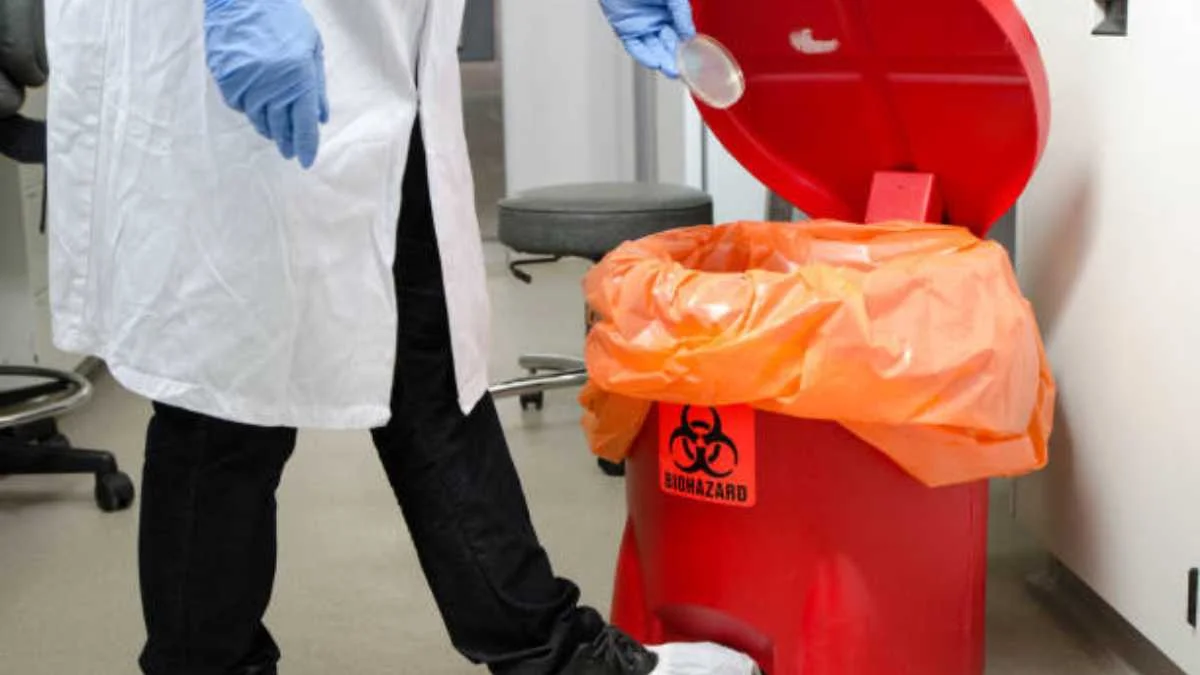HEALTH AND FITNESS
The Importance of Safe Medical Waste Disposal: Protecting Public Health and the Environment

In healthcare settings, medical waste management plays a critical role in protecting both public health and the environment. Medical waste, which includes biohazard waste, pharmaceutical waste, and sharps, can pose significant risks if not properly handled and disposed of. To avoid the potential dangers of contamination, infection, or environmental harm, it is essential that healthcare facilities, pharmacies, and medical laboratories implement safe and compliant medical waste disposal practices.
In this article, we’ll explore the importance of safe medical waste disposal, highlighting the risks of improper management, the key types of medical waste, and best practices for protecting the environment and ensuring regulatory compliance.
Table of Contents
The Dangers of Improper Medical Waste Disposal
Improper disposal of medical waste has far-reaching consequences. Not only does it endanger healthcare workers, patients, and the general public, but it also leads to environmental damage that can last for years. The accumulation of medical waste in landfills or its improper treatment in incinerators can release hazardous substances into the air, water, and soil, threatening ecosystems and human health.
1. Infection and Disease Transmission
One of the primary dangers of mishandling medical waste is the potential for infection and disease transmission. Biohazard waste, which includes materials like blood, tissue, and contaminated personal protective equipment (PPE), can harbor dangerous pathogens. If these materials come into contact with healthcare workers, patients, or sanitation workers, they may cause infections such as hepatitis B, hepatitis C, or HIV.
Sharps waste, which includes needles, syringes, and scalpels, is particularly risky due to the potential for needlestick injuries. A single needlestick injury from contaminated sharps can expose an individual to bloodborne pathogens, leading to severe health risks. Proper handling and disposal of sharps waste is therefore critical to prevent accidental injuries and infections.
2. Environmental Contamination
Improper disposal of medical waste, especially pharmaceutical waste, can have devastating environmental consequences. Pharmaceutical waste disposal requires careful attention because chemicals from medications can leach into soil and water supplies if not disposed of correctly. This contamination can affect both wildlife and human populations, as these substances often enter drinking water systems or harm aquatic life.
Hazardous medical waste that contains chemicals or radioactive materials can also release toxins into the environment if it is not treated through safe disposal methods like incineration or autoclaving. Protecting ecosystems from these pollutants is a fundamental aspect of medical waste management.
3. Legal and Regulatory Consequences
Failure to comply with local, state, and federal regulations governing medical waste disposal can result in severe legal and financial consequences for healthcare facilities. Regulatory bodies, such as the Occupational Safety and Health Administration (OSHA) and the Environmental Protection Agency (EPA), enforce strict guidelines to ensure that healthcare organizations handle medical waste in a manner that protects both public health and the environment.
Non-compliance can lead to fines, lawsuits, and reputational damage, making it essential for healthcare providers to adhere to proper disposal practices. Organizations like Ecowaste Solutions help healthcare facilities stay compliant by offering comprehensive waste disposal services that meet all regulatory standards.
Key Types of Medical Waste
Medical waste encompasses a wide variety of materials, each requiring specific disposal methods. Understanding the types of medical waste is crucial for ensuring proper management and minimizing risks.
1. Biohazard Waste
Biohazard waste, also known as infectious waste, includes any material that may be contaminated with infectious agents. This category encompasses:
- Blood and bodily fluids: Contaminated bandages, gauze, and other materials exposed to blood or body fluids.
- Pathological waste: Human tissues, organs, and surgical specimens removed during medical procedures.
- Contaminated PPE: Gloves, masks, and gowns used in medical treatments and surgeries.
Proper containment and disposal of biohazard waste are essential to prevent the spread of infectious diseases. Biohazardous materials should be placed in specially marked, leak-proof containers, and they must be treated through incineration or other approved methods before final disposal.
2. Sharps Waste
Sharps waste includes any object that can puncture or cut the skin, such as needles, scalpels, lancets, and broken glass. Because of the high risk of transmitting bloodborne pathogens, sharps waste must be handled with extreme care.
Sharps should be disposed of in puncture-resistant containers that are clearly labeled as hazardous. These containers must be placed in areas where sharps are used, such as operating rooms, clinics, and labs, to ensure immediate disposal after use. Overfilling sharps containers should be avoided, as it increases the risk of injury.
3. Pharmaceutical Waste
Pharmaceutical waste disposal presents a unique challenge due to the chemical nature of many medications. This waste includes expired or unused medications, as well as drugs that are classified as hazardous under the Resource Conservation and Recovery Act (RCRA). Examples include chemotherapy drugs, certain antibiotics, and narcotics.
Pharmaceutical waste must be segregated from regular waste and disposed of in compliance with DEA and EPA regulations. Methods like incineration or chemical treatment are commonly used to neutralize hazardous pharmaceutical waste. Facilities must also track and document the disposal process to maintain compliance with regulatory agencies.
Best Practices for Safe Medical Waste Disposal
To mitigate the risks associated with medical waste, healthcare facilities should adopt best practices that prioritize safety, environmental responsibility, and regulatory compliance.
1. Segregation at the Source
Effective medical waste management begins with segregation. Healthcare workers should separate waste into appropriate categories at the point of generation. This ensures that biohazard waste, sharps, and pharmaceutical waste are disposed of using the correct methods.
Using color-coded containers and clearly labeling waste bins are essential steps in maintaining proper segregation. For example, red containers are typically used for biohazard waste, while yellow containers are reserved for sharps.
2. Staff Training and Education
Healthcare staff must be adequately trained in medical waste disposal procedures. Regular training sessions should cover how to handle different types of waste, the importance of personal protective equipment (PPE), and the risks associated with improper disposal.
Staff should also be educated about the specific regulations governing medical waste, including the guidelines set by OSHA and the EPA. Ongoing training ensures that all employees are aware of their responsibilities and know how to safely manage waste materials.
3. Use of Professional Waste Disposal Services
Due to the complexities of medical waste disposal, many healthcare facilities partner with professional waste management services like Ecowaste Solutions. These providers specialize in handling and disposing of medical waste in accordance with regulatory requirements. By outsourcing waste management, facilities can ensure compliance, reduce the risk of human error, and focus on patient care.
Professional waste disposal companies also offer secure transportation of medical waste, ensuring that it reaches treatment facilities safely and without the risk of contamination during transit.
4. Compliance with Regulations
Adhering to regulatory standards is crucial for minimizing legal risks and ensuring that medical waste is disposed of in an environmentally responsible way. Healthcare facilities should stay informed about the latest guidelines from OSHA, the EPA, and local authorities, and they should conduct regular audits to ensure compliance.
Maintaining detailed records of waste generation and disposal is also necessary to demonstrate compliance with regulations and avoid penalties.
Conclusion: Prioritizing Health and Safety Through Effective Medical Waste Disposal
Safe medical waste disposal is essential for protecting public health, preventing environmental contamination, and ensuring regulatory compliance. Healthcare facilities must prioritize proper handling, segregation, and disposal of biohazard, pharmaceutical, and sharps waste to mitigate the risks associated with medical waste.
By following best practices and partnering with professional waste disposal providers like Ecowaste Solutions, healthcare organizations can maintain a safe and compliant environment, safeguarding both their staff and the broader community from the dangers of improper waste management.
-

 GENERAL6 months ago
GENERAL6 months agoChristofle – For Those Who Dream of Family Heirloom Silver
-

 SPORTS8 months ago
SPORTS8 months agoDiscover the World of Football with Streameast: Watch Your Favorite Leagues and Tournaments
-

 GENERAL4 months ago
GENERAL4 months agoUncovering the World of кинокрадко: The Dark Side of Film Piracy
-

 GENERAL2 months ago
GENERAL2 months agoATFBooru: Anime, Gaming, and Subculture Imageboard



























